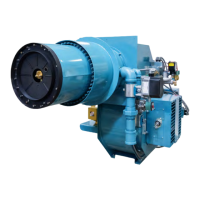Page 21
SC Manual
Startup and Operating Adjustments
m. Operate the burner until the boiler is warmed up
and near the operating pressure or temperature.
Increase the ring rate. Put the low re hold switch
in auto mode, while monitoring and adjusting the
O
2
level. Adjust the gas pressure regulator as
needed to reach the high re input.
n. Adjust the high re input to match the maximum
input listed on the rating label. At high re, the gas
buttery valve should be at least 75 degrees open
(more if available gas pressure is low), and the gas
pressure regulator adjusted to obtain the rating.
The input should be measured using the following:
Calculating Natural Gas Input
Gas MBH =
HHV x [(Patm + Pgas)/29.92] x [520/(Tgas +460)] x
[measured ft3/sec] x [3600 sec/hr]
Where:
MBH = 1000’s of BTU/H input
HHV = Higher heating value of gas, BTU/cubic feet
Patm = Atmospheric pressure in inches Hg
Pgas = Gas pressure before gas meter in inches Hg
(inches HG = PSIG x 2.04)
Tgas = Gas temperature at the ow meter, in
degrees F
Measured ft
3
= volume of gas measured by meter
sec = Time for measured ft
3
to ow through meter
Note: Some gas meters require a 6 inch wc correction
to Pgas. Consult your meter calibration data.
NOTE: The listed manifold pressures are an approxi-
mate value and can vary with operating conditions
and normal tolerances. The fuel ow rate must be
measured to obtain an accurate input value.
o. Adjust the air damper to obtain the correct NOx
and CO levels.
p. Modulate the burner to low re, adjusting the O
2
level as the burner modulates to match the desired
emission level.
q. Adjust the low re input and air damper
adjustments. If the NOx is too high, close the
primary buttery valve more. If the CO is too high,
close the air damper in small increments.
r. Re-adjust the midre points for the correct emission
level.
s. Adjust the low gas pressure switch to be 10% below
the lowest expected gas pressure.
• With a gauge or manometer at the same location
as the low gas pressure switch, modulate the
burner to determine the ring rate with lowest
gas pressure.
• At the lowest gas pressure, adjust the low gas
pressure setting up until the switch breaks and
causes the burner to shutdown.
• From the scale reading of the switch, adjust the
setting to a pressure that is 10% lower than the
shutdown pressure. For example, if the switch
opened at 10 inches as indicated on the low gas
pressure switch, the switch should be adjusted to
a reading of 9 inches.
• Remove gauge or manometer and plug opening.
• Cycle the burner on and off to determine if the
limit works properly.
• If the limit causes nuisance shutdowns because
of small pressure drops during startup, reduce
the pressure setting an additional 5%.
t. Adjust the high gas pressure switch to be 10%
above the highest expected gas pressure.
• With a gauge or manometer at the same location
as the high gas pressure switch, modulate the
burner to determine the ring rate with the highest
gas pressure.
• At the highest gas pressure, adjust the high gas
pressure setting down until the switch opens and
causes the burner to shutdown.
• From the scale reading of the switch, adjust the
setting to a pressure that is 10% higher than the
shutdown pressure. For example, if the switch
opened at 10 inches as indicated on the high gas
pressure switch, the switch should be adjusted to
a reading of 11 inches.
• Remove the gauge or manometer and plug the
opening.
• Cycle the burner on and off to determine if the
limit works properly.
• If the limit causes nuisance shutdowns because
of small pressure changes during startup,
increase the pressure setting an additional 5%.
u. The burner should be operating at low re to
adjust the air proving switch. Turn the adjusting
screw cw (in) until the burner trips out (shutdown
caused by the air ow switch). Turn the adjustment
screw ccw (out) 1 1/2 turns from the point of
shutdown. Check the operation at higher rates.
4. Pressure Atomized Oil Setup
The pressure atomized oil system has a limited range of
adjustment for low and high re, dictated by the operation
of the oil nozzle. The combustion air must be adjusted to
match these rates.
a. Place the burner switch in the “OFF” position.
b. Place the burner management system in manual
mode. If this is a combination fuel burner, make sure
the fuel selector switch is on “OIL”.
c.
Place the burner management system in the low
re position.
d. Turn the electrical power for the burner, boiler and
related components on.
e. Verify that the oil metering valve is nearly opened
(the valve will be closed at high re).
f. Turn the burner switch on. This will start the blower
motor and initiate the purge cycle.

